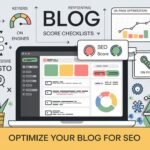In today’s digital world, blogging is more than just a hobby; it’s a powerful tool for businesses to connect with their audience, build credibility, and drive growth. If you’re not already blogging, it’s time to give it your full attention. Here’s why:
The Power of Blogging:
- Engagement: Not only do 80% of internet users read blogs, but they also interact with them in various ways. This includes commenting, sharing on social media, subscribing to newsletters, and clicking on links within blog posts. This high level of engagement makes blogs a valuable platform for building relationships with potential customers.
- Marketing Priority: The reason 53% of marketers prioritize blogging is that it offers a versatile platform to achieve various marketing goals. Blogs can be used to generate leads, build brand awareness, educate customers, and drive traffic to a website.
- Increased Traffic: The sweet spot of 4-16 blog posts per month suggests a balance between consistency and quality. Posting too frequently might lead to lower quality content, while posting too infrequently might not be enough to maintain audience interest and search engine visibility.
How Blogging Benefits Your Business:
1. SEO Boost:
- Valuable Content: Google’s algorithms prioritize content that is informative, relevant, and engaging. By creating high-quality content that addresses your audience’s needs and interests, you increase the likelihood of earning backlinks from other reputable websites. This, in turn, signals to Google that your website is a valuable resource, boosting your search ranking.
- Inbound Marketing: Instead of interrupting your audience with intrusive ads, blogging attracts them to your website by providing valuable information. This approach is more likely to resonate with today’s consumers, who are increasingly wary of traditional advertising.
2. Long-Term Growth:
- Sustainable Results: While paid advertising can deliver immediate results, its effects are often short-lived. Blogging, on the other hand, builds a lasting online presence that can continue to generate leads and drive traffic for years to come.
- Customer Journey: Blogs can be strategically used to cater to different stages of the customer journey. For example, you can create top-of-funnel content (like blog posts about industry trends) to attract new visitors, middle-of-funnel content (like how-to guides) to educate and engage prospects, and bottom-of-funnel content (like case studies and testimonials) to persuade leads to convert.
3. Establish Expertise:
- Thought Leadership: By consistently sharing insightful and well-researched content, you can position your business as a thought leader in your industry. This can lead to speaking engagements, media opportunities, and collaborations with other industry experts.
- Building Trust: Sharing your knowledge and expertise through blog posts demonstrates transparency and builds trust with your audience. When people trust your brand, they are more likely to do business with you.
4. Add Value:
- Beyond Sales: While ultimately you want your blog to contribute to your business goals, it’s important to focus on providing value to your readers first and foremost. This means creating content that is informative, engaging, and helpful, even if it doesn’t directly promote your products or services.
- Customer-Centric Approach: By prioritizing your audience’s needs and interests, you demonstrate a customer-centric approach that can differentiate your brand from competitors.
5. Brand Building:
- Define Your Brand: Your blog is an extension of your brand. Use it to communicate your brand values, personality, and unique selling propositions. Consistency in tone, style, and visuals will help create a strong brand identity.
- Increased Visibility: As your blog gains traction and attracts more visitors, your brand will become more visible online. This can lead to increased brand awareness and recognition.
6. Gather Feedback:
- Market Research: Encourage readers to leave comments on your blog posts, providing valuable feedback on your content and insights into their needs and preferences. You can also use surveys and polls to gather more specific information.
- Social Listening: Pay attention to how people are interacting with your blog posts on social media. Are they sharing your content? What are they saying about it? This information can help you understand what resonates with your audience and adjust your content strategy accordingly.
7. Generate Leads:
- Email Marketing: Offer valuable lead magnets, such as ebooks, checklists, or webinars, in exchange for email subscriptions. This allows you to build an email list and nurture leads with targeted content and offers.
- Increased Engagement: By regularly engaging with your audience through blog comments and social media, you can build relationships and increase the likelihood of conversions.
8. Fuel Social Media:
- Content Repurposing: Don’t let your blog content go to waste. Repurpose it into different formats for social media, such as infographics, short videos, and quote cards.
- Organic Social Media Marketing: Sharing your blog posts on social media can drive traffic to your website and increase your reach. It also provides valuable content for your social media channels, keeping your audience engaged.
My Perspective:
Blogging has become an integral part of my online identity. It allows me to connect with like-minded individuals, share my passions, and contribute to the online community. For businesses, blogging offers a unique opportunity to humanize their brand, build trust, and establish themselves as a go-to resource in their industry. By embracing blogging and creating valuable content, businesses can unlock a world of opportunities for growth and success.







